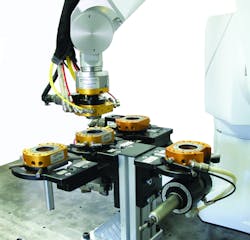ATI Industrial Automation (www.ati-ia.com), a developer of robotic peripheral equipment, broke ground in Nov. 2011 to expand operations at its corporate headquarters in Apex, N.C. The expansion is planned for completion in early 2012.
CEO Keith Morris said the move was driven by high demand for company’s end-effector products, including robotic tool changers, multi-axis force/torque sensing systems, and robotic collision sensors. Plans call for more than doubling current manufacturing and inventory capacity and hiring 50 new employees.
ATI’s flagship product is the Robotic Tool Changer, a robotic wrist coupling that locks and unlocks automatically, allowing a single robot to perform many different tasks. NASA, Ford and Honda are major customers, Morris said.
ATI was established in 1989 out of a small office in Garner, N.C., by three engineers and current ATI employees: Morris; COO Robert Little; and Chief Sensor Technologist Dwayne Perry. Over the last 22 years, ATI has grown from a handful of employees to more than 150 with offices in Michigan, China, and Brazil.
About the Author
Renee Bassett
Managing Editor

Leaders relevant to this article:
